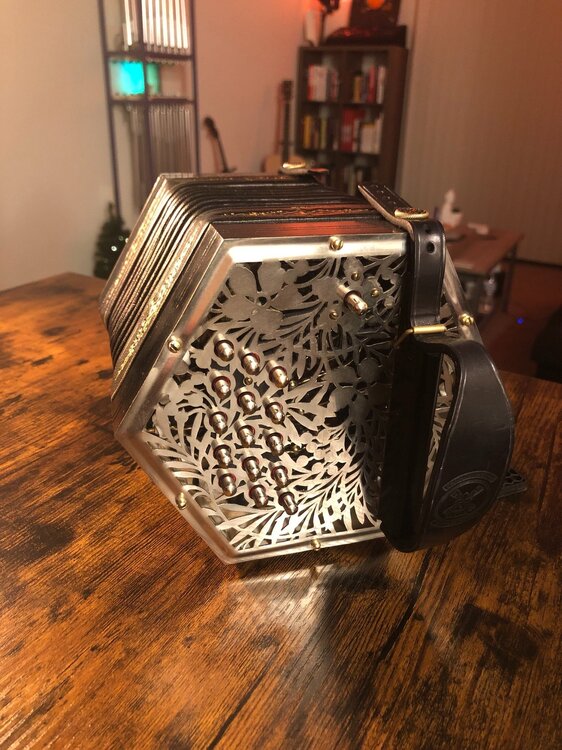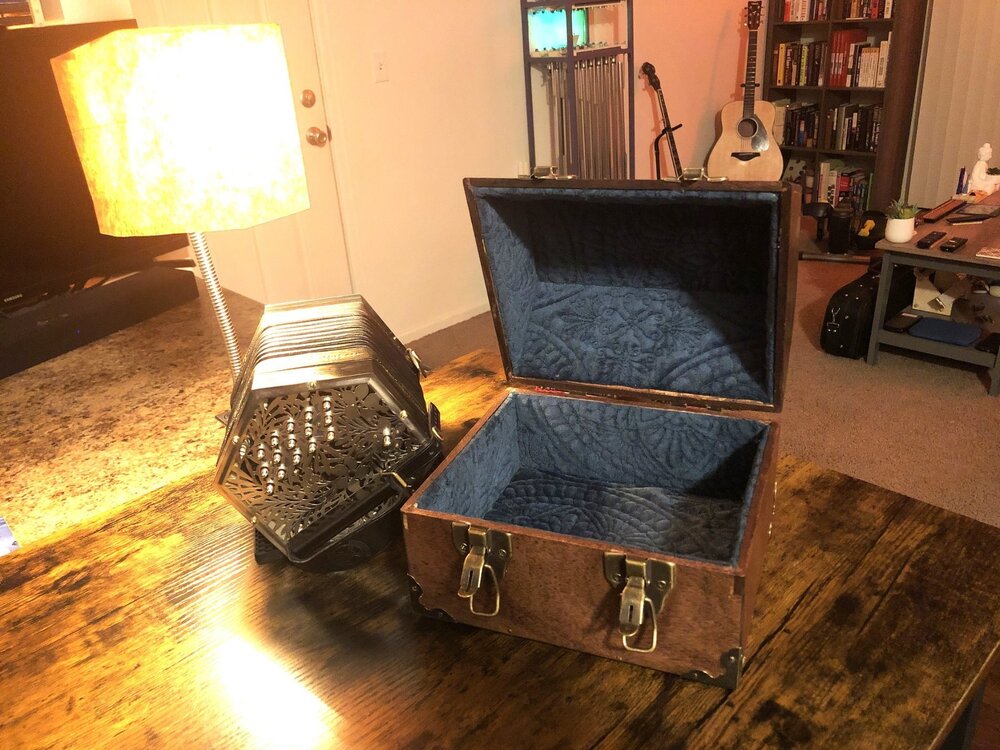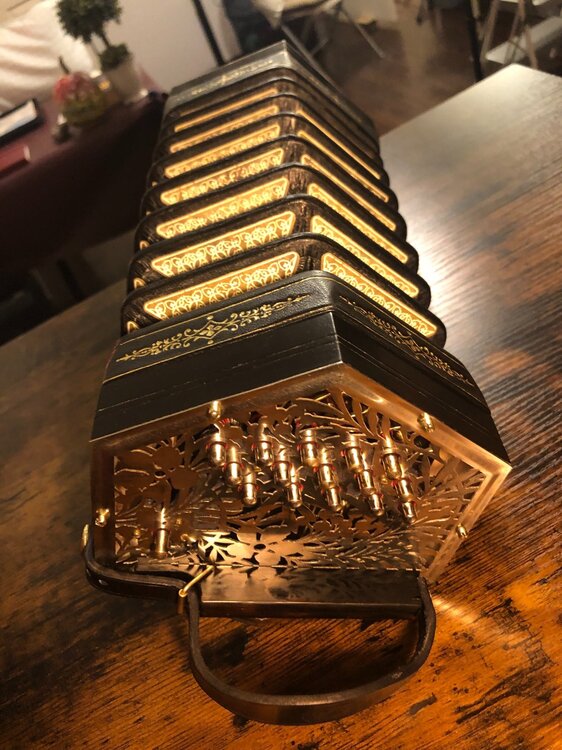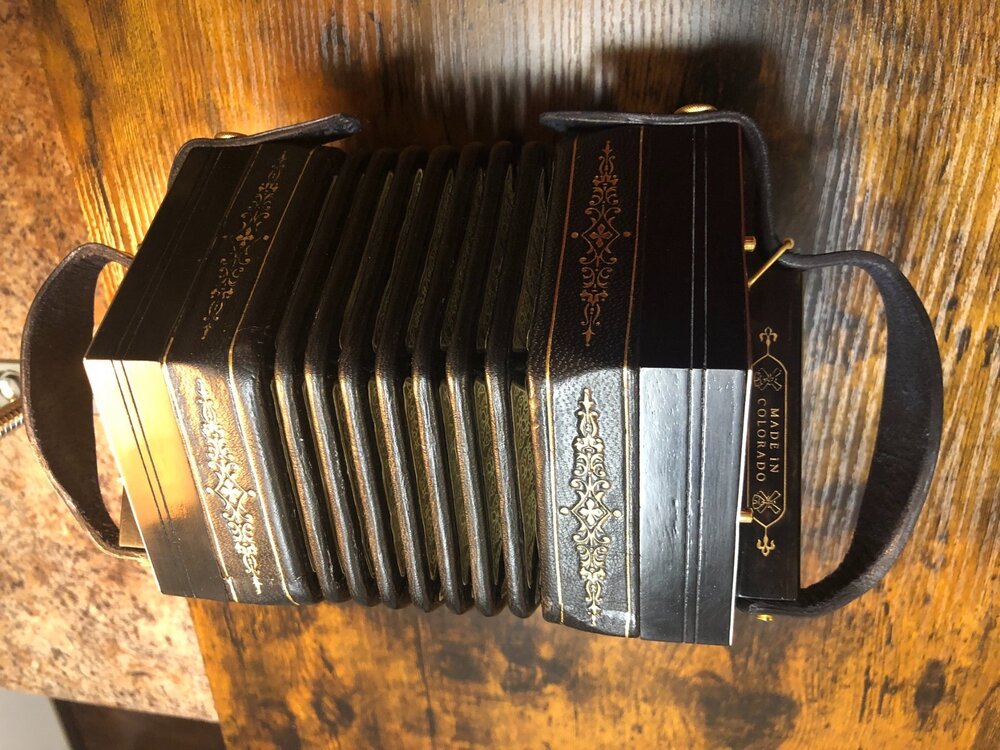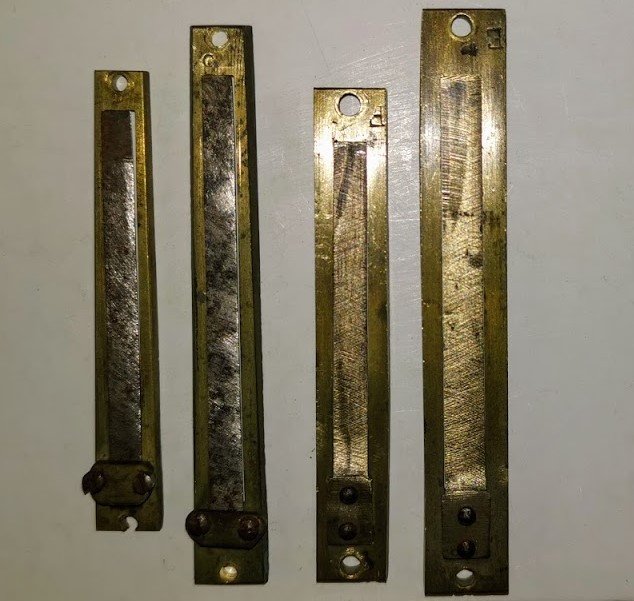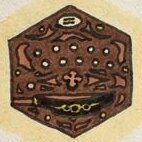Search the Community
Showing results for tags 'Reeds'.
-
This is my 2¢ about a lesser-known maker I had the good fortune to meet last year ~ I just received a new C/G anglo from Crook Concertinas. I waited a mere 3 months to get it. Details and description below - And here is the contact information for the maker: Crook Concertinas Williespoke@gmail.com 303-960-3701 https://www.instagram.com/crook_concertinas/ https://www.youtube.com/@CrookConcertinas/ Willie Crook says the best ways to contact him are email and direct message on Instagram. This thing is hard to put down. The tuning is impeccable and the reeds respond so quickly that I'm still adapting to it, feeling like I'm learning how to drive a modern car after coasting to work in an old Datsun. His workmanship is detail-oriented to an uncommon degree - he even puts effort into the beauty and polish of the normally-hidden internal mechanism just in case someone opens it up to have a look. I toured his Colorado shop in November. A machinist with his talent and experience could be making governors for Woodward or injectors for Boeing or whomever. Instead, Willie Crook is building little button boxes for the likes of us. And they perform QUITE nicely. He makes three sizes - 5⅝", 6¼", and a baritone. He pours a lot of time and energy into his handmade concertina reeds. (See his youtube channel.) He has various options for woods, buttons, and bellows papers. Endplates can be wood or metal, and the particular pattern I chose is unique to Willie's concertinas. ¯\_(ツ)_/¯ So how did I end up with one of these? This fall I realized I wanted another concertina, and I spent time reaching out to every maker for whom I could get contact information. After several attempts, many (including a few well-known names) have remained unreachable. But I took detailed notes when someone responded, and collected data on about 30 makers. In the end I learned some interesting things, and talked with a lot of players about whatever they had in the case. There are lots of good-looking possibilities out there, but of course many have raised prices dramatically, and many have a waiting list which is several years long. We're used to this, I suppose. But I made a project out of talking to everyone because I wanted something good. People had only positive things to say about Willie's concertinas. He operates in Denver and he is an easy maker to reach. When my instrument was finished we had a session in his kitchen, sipping tea and trying out old tunes on the new machine. This maker plays concertina and plays it well, and he maintains a high standard for the shiny contraptions leaving his shop. We live with the fact that looking for a good concertina is a bit harder than shopping for a violin or a guitar. I think Crook Concertinas is a great option for someone who wants a meticulously-made, high-performance instrument, doesn't want to pay over the top of the current price spectrum to get something from one of the big concertina dynasties, and doesn't want to wait until the end of the Holocene extinction for it.
- 25 replies
-
- 3
-

-
- crook concertinas
- makers
-
(and 3 more)
Tagged with:
-
A little while ago I acquired a large 40 key English concertina, which apperared to have been originally pitched somewhere between bass and baritone. A previous owner had started some dastardly modifications to the reedpan which rendered it unlikely to ever be reinstated in its original form. In the fullness of time I intend to make new ends and reedpan in anglo format. In all there were 80 reeds, some in the reedpan, others separately bagged. In the upper register, they are all conventional concertina style reeds to fit into dovetailed slots. The rest of them are surface mount. Some of these appear to be standard larger surface mount concertina reeds, steel tongues and conventionally stamped as you would expect to find in a traditionally made bass/baritone instrument. Others are brass reeded with stamping that suggests they are probably taken from an old harmonium - some have continental stampings on to indicate the notes. They are quite a size but I will probably have enough space to accomodate them - they sound quite good on a tuning rig. Picture attached showing both brass and steel reeded versions, the two on the left I would suggest are made by an English concertina maker. 1. Does anyone out there have any experience of using harmonium reeds in a conventional concertina? What are the drawbacks? 2. I'm short of a good few bass reeds in the lowest register, two octaves below middle C - anyone out there have any available?
-
HOHNER English Concertina 48Key treble reveted action with accordion reeds. Push and pull should be F6, but E6 comes out by pushing. Can I tuning the reeds up one note? For this, I made a tuning bellows, but I have absolutely no skill in tuning.
-
Hi everyone, I'm finally looking to upgrade my Mcneela Wren after a couple of years of playing on it. I'd really like to invest in something for the long haul, but even after doing some research I'm a little confused on what constitutes "hybrid" reeds from traditional concertina reeds. My current understanding is that hybrid concertinas use accordion reeds rather than traditional concertina reeds Do the sellers that offer "tipo a mano" mean that these are made in the traditional way? For instance, I see the Morse Ceili recommended quite a bit - is this still a hybrid concertina? If not, are there any makers that still offer reeds in the traditional way, or is this exclusive to vintage concertinas from makers like Lachenal? Thank you! Alex
-
Evening all, I thought i'd share my recent emotional roller coaster with my new Lachenal 20 key with brass reeds. it's had some pretty heavy use what with my renewed motivation upgrading from a Scarlatti and to my dismay 2 nights ago I realised the a1 button not sounding! being a novice I had no idea why this might be- broken reed, a broken mechanism- i envisaged an expensive repair job and stewed over the posts describing these instruments as inferior and prone to breaking down. Boo hoo i thought. However, i stumbled across some threads here regarding fluff/debris in the reeds- with great trepidation I opened my anglo and after working out which reed it was I gently flicked it with a stanley blade and gave it a jolly good blow- Success! The note returns, and I can plough on with my Zelda iterations. What relief. The highs and lows of a new instrument. A great satisfaction in diagnosing and treating this simple problem myself. Has anyone had similar experiences?
- 10 replies
-
Hi, This Christmas, a friend’s dad gave me an old Lachenal 30-button Anglo that had been in his family for generations. Unfortunately it is in a pretty sorry state, but as an aspiring musical instrument restorer, I have decided to have a crack at mending it myself (with the help of our friend's tools and DT experience). It is a beautiful instrument, with hardwood ends and bone buttons, steel reeds and a 5-fold bellows. As the photos show, it is a bit dirty (nothing some good cleaning can’t handle) and has had the bellows poorly repaired in the past with what looks like plasters…? Inside, the left hand reeds are quite rusty, while the right hand ones seem alright. The buttons also seem to be popping out of their guide holes, so they have to be wiggled around a bit before you can press them down. It also has some writing inside, saying it was tuned by a Wooding of Newcastle-under-Lyme in 1897, and an address that is only legible in bits, but appears to say: (something something something) 170 (something) road Cliff Vale Stoke-on-Trent Dec (something)/96 The main problems will be de-rusting the reeds and patching up the bellows (which have got more than their fair share of holes in). If anybody out there has any ideas or advice they could give me, whether that’s on the history of the instrument or how to repair it, it would be greatly appreciated by both me and my friend’s family. Please find attatched some photos of the instrument. Thanks! Here is a video of the state of the bellows:
-
Hi, apart from the specific sound, which I am not underestimating or dismissing, what are the differences between the two reeds? Is the concertina reed more responsive or is this solely down to construction? Louder or again is that timber/construction influenced? I definitely get the more attractive sound from the concertina reed but am curious as to what else I would get in general by upgrading. I appreciate of course the variables between the general qualities, such as between a cheap or poor accordian reeded and a Dipper for example but am wondering about the differences that the two reeds specifically bring to the experience. TIA
-
I'm looking into ordering a (accordion style) reed set for a 30 key C/G anglo build I have under work. I have an "early" Rochelle at the moment and through the build I hope I will get at least a smaller and lighter instrument. Aiming for an upgrade in the playability as well. Buying a better instrument unfortunately is not an option at the moment as money is scarce. Looking through the forum posts it seems several people have ordered reed sets from Harmonikas. I would appreciate any shared insight into ordering specifics (e.q. how did you specify the set) and price differences between sets (A mano professional, Tipo a mano & export dural). Also how am I supposed to read the plate dimensions (sortiment sizes pdf)? I'm not familiar with reed combinations used in accordions, so would the dimensions be different for reed-combinations specific for a concertina? Or would you happen to have them for a 30k c/g set? I'd like to start working on (drawing and machining) the reedpans as my access to a cnc milling tool is limited and in worst case any workshop access might come to an abrupt end. I'm aware it's not the ideal order of doing things but ah so it go.
- 4 replies
-
- reeds
- harmonikas
-
(and 4 more)
Tagged with:
-
I didn't really panic, but I was getting worried. The draw A in the left-hand G-row of my recently acquired Dallas-Crabb Anglo was a bit flat. When I got it, a few months ago, everything had been in tune, if I remember rightly. But in the last week, the offending reed was getting flatter and flatter, and also sounded muted and didn't achieve even its flat pitch under light pressure, only when forced. I took the end off to see if there was any debris in the chamber, but there wasn't. The set of the reed looked much the same as its neighbours, and the valve was equally inconspicuous. The reed was now seriously flat - 30 cents, according to my tuner. So, still suppressing the panic, I decided to make my first attempt at tuning a reed. I removed the reed-pan, and got the reed out quite easily. When I had it in my hand, I noticed that there was some kind of dark brown deposit on the shoe, especially where the reed is clamped to it. The deposit was inside the slot as well. "Cleanliness is next to godliness," as they say, so before doing any filing I got terpentine, a soft cloth and a toothpick and cleaned the brown stuff off and out of the crevices. To check the flatness, I reassembled the end, and lo and behold! the offending note was as loud and clear as all the others, spoke immediately, and was in unison with the draw A in the C row! To quote another adage, "A job begun is a job half done." In this case, a job begun was a job completed. I then carefully played each note, and, listening carefully, noticed that a couple of other reeds were just starting to show a trace of this muting and reluctance to start quickly and to reach full pitch right away. so I cleaned them as well, and they came up bright and shiny, acoustically as well as visually. So I plan to clean all the reeds, a few at a time, with the prospect of playing a really brilliant concertina. So the moral of the story is, even if a reed sounds disastrously off, it may just need cleaning, so don't panic! I've learnt a lot about maintenance in this forum, but I don't recall reading anything about crud causing serious tuning problems. But it does! I'll just have to postpone my first attempt at tuning - thank Heavens! Cheers, John
-
Hi all. I am new to the concertina world and own a Rochelle Anglo. Been playing for 4 months now and love it. I play it at least an hour daily, and use it when I visit folks in nursing homes, etc. Since I am a minister, I use it more than weekly with nursing home visits and visiting shut-ins at home. I do put it to work a lot. I don't know if transporting it has caused the problem below or not, but I do know of no rough events, just a lot of use. I had one problem and received advice from the Button Box folks when a note went out -- had a silent note, tapped the reed with a screwdriver lightly, and that fixed it. Now I have another problem. When I play a (first space at bottom of staff) F, the note plays but sounds distorted, as though I were pushing too much volume through a cheap speaker. The E has a little bit of this, but not as much. The notes might be slightly louder than other notes, I think. If i play with the left side (where the note is) aimed downward, the distortion is less than if I play that note upward. I keep the concertina on my right knee. Sometimes the note will sound cleaner. I tried putting a piece of paper under the reeds, or lifting the plastic strip and lightly touching a screwdriver to the reeds opposite to remove debris that might be causing this. I am not sure where the F reed itself is located. Is it on the top, next to the E? Or is it in the mid-section or bottom? My instincts tell me the top. Or might it not be the reeds at all? Or is one of the plastic strip flaps inappropriately vibrating?.Or might it be a bellows issue? Any help appreciated. I can get by playing, and I probably notice the distortion more than listeners. If necessary, I will call the Button Box folks again, but thought I would inquire first here. Thanks!
-
CONCERTINA Hello, I sell complete set of reeds. 42 reeds, i bought 2 low reeds more in the same size in case I wanted to change the tuning layout of the second row - the lowest button from G/d to B/A I wanted to build my own anglo CG concertina, however I don’t have enough time to do so. So i decided to sell this complete set of reeds. The reeds are pre tuned manually in the factory. They are fine quality reeds from czech manufacturer, see the site. In case of interest contact me and I would send you complete sheet with size and pitch of every single reed. Price is 160 euros. Thank you Adam http://www.harmonikas.cz/en/dix-concertina-1#obsah
-
A discussion on the defining Wheatstone's golden age resulted in discussions on materials, end plate design, fret work etc. and I started thinking about how the vibrations travel through a concertina... I thought it would be more appropriate to pick it up here... I don't really understand how the ends affect the sound as it's a total mystery how the reed generated air vibrations even travels through a concertina. For example, with two sets of reeds on an English, why are there reed pan chambers only on the outside of the pan? Wouldn't this chamber only be active on press when the air inside the bellows flows through the inside reed, pulsates or cuts up the air flow causing a tone, goes through the valve then into the chamber and finally out through the open pad hole and out the fret work. But what about on pull when the air flows inward? Does the sound still go outward? Probably a dumb question but it appears it does and so a total mystery to me! I've always wanted to make some models to experiment with how the sound travels through then start doing experiments with chamber sizes, pad hole sizes, reed scaling, etc... even how the thickness of valve material affects the tone. I've asked this a few times with conflicting answers. Maybe someone could explain it quickly and especially the affects of different valve thicknesses and stiffnesses. Why are shallow reed pans louder? What about mahogany reed pans? And this is all apart from the different types of reed material which radically affects the tone. It would be awesome to be able to go back 90 years and pick the brains of one of Wheatstone's master builders. Wouldn't that be something?!!
- 38 replies
-
- Reeds
- Vibrations
-
(and 3 more)
Tagged with:
-
I'm tuning a 30 key lachenal at the moment, and having some trouble with 2 of the reeds on the top row right side - I keep trying to sharpen them but it gets flatter. Both are long enough that it's not because of filing in the wrong place by mistake. On the charts I've seen, both should be d# in a lachenal, but the ones in mine are both eb, I don't know if that has anything to do with the problem. ANyone have any idea why this might be?
-
A few of the higher reeds on my 1914 Wheatstone English tenor-treble sound thin, with less volume than others. I suspect the instrument has been played a lot more in its middle and lower ranges than up high, so part of the difference might be a difference in how much playing-in the different reeds have undergone over the years. The feeble notes speak quite freely and start just as quickly as the others - they just produce a noticeably weaker sound. I have a later Wheatstone (1928) and that has a fairly consistent volume up the scale, which I'd like to achieve in the 1914 one. Is this possible? How can I turn up the volume a tad on those weaker notes? In some cases it's just one of the pair - so the draw speaks louder than the pull or vice-versa. Any guidance would be appreciated. Ray
-
I've been learning about tuning reeds, by embarking on retuning a brass-reeded Lachenal tutor to concert pitch from old philharmonic pitch. I bought it as a wreck some years ago and have been restoring it intermittently - see lachenal_52313.html. I realise that retuning is hard, and tedious, and I'm likely to make mistakes, but I'd prefer to make mistakes on this instrument which will never be a great one. A famous physicist once said that an expert is someone who has made all the possible mistakes in their subject! I've done a first pass on all the reeds, and now doing a second pass. It's all going reasonably well, except that I have three reeds which are within four cents of true pitch when blown gently, but when the pressure is increased slightly, they warble and go sharp. There was another like that, but by repeatedly tweaking the setting of the reed in the frame I managed to make it OK. However the remaining three (low Ds and B on RHS) are resisting my efforts. So, does anybody have any hints for how to correct that scenario? I've already tried cleaning the edge of the reed and the frame. Note that this happens when the reed is in an external tuning jig, as well as when re-inserted into the instrument, so it's nothing to do with the fit of the frame in the wood slot. It is of course quite possible that in my learning, I've manage to file the reed to a strange cross-section, so if nobody can suggest a solution, I could send the reeds off to Concertina Spares to be replaced or fixed, but I'd like to understand the cause of the problem and see if I can fix it myself if someone can suggest an approach. In general, are there any hints on setting of reeds beyond the description in Dave Elliot's Concertina Maintenance Manual? Regards,
-
Hello all. my 1st posting on this forum being new to the Concertina as a new venture from other instruments. I read that better instruments have "real" Concertina reeds as opposed to Accordion reeds fitted in cheaper instruments. Please explain the difference? No doubt this has been discussed before but I can't find suitable thread to answer this question.

